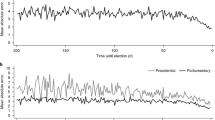Abstract
This paper uses pre-election polls to forecast U.S. Presidential election outcomes in the states and the Electoral College. The approach is notable in three ways. First, we employ state-level polls to predict voting outcomes in the states; second, we associate probabilities with alternative election outcomes, and third, we identify states most likely to be pivotal in the Electoral College. Using information available on the day before the election, we estimated that the probability of a Republican victory in the Electoral College in the 2004 election was 47.27%.
Similar content being viewed by others
References
Abramowitz, A. (1996). Bill and Al's excellent adventure: Forecasting the 1996 presidential election. American Politics Quarterly, 24, 434–442.
Abramowitz, A. (1992). An improved model for predicting presidential outcomes. PS: Political Science and Politics, 21, 843–847.
Brown, L., & Chappell, H. (1999). Forecasting presidential elections using history and polls. International Journal of Forecasting, 15, 127–135.
Campbell, J., & Wink, K. (1990). Trial-heat forecasts of the presidential vote. American Politics Quarterly, 18, 251–269.
Campbell, J. (1992). Forecasting the presidential vote in the states. American Journal of Political Science, 36, 386–407.
Campbell, J. (1996). Polls and votes: The trial heat presidential election forecasting model, certainty, and political campaigns. American Politics Quarterly, 24, 408–433.
Crain, W., Messenheimer, H., & Tollison, R. (1993). The probability of being president. The Review of Economics and Statistics, 75, 683–689.
DeSart, J., & Holbrook, T. (1999). Using state polls to forecast presidential election outcomes in the American states. International Journal of Forecasting, 15, 137–142.
Erikson, R. (1989). Economic conditions and the presidential vote. American Political Science Review, 83, 567–573.
Erikson, R., & Wlezien, C. (1996). Temporal horizons and presidential election forecasts. American Politics Quarterly, 24, 492–505.
Fair, R. (1996). Econometrics and presidential elections. The Journal of Economic Perspectives, 3, 89–102.
Fair, R. (1978). The effect of economic events on votes for president. Review of Economics and Statistics, 60, 159–173.
Fair, R. (1982). The effect of economic events on votes for president: 1980 results. Review of Economics and Statistics, 64, 322–325.
Fair, R. (1988). The effect of economic events on votes for president: 1984 update. Political Behavior, 10, 168–179.
Kramer, G. (1971). Short-term fluctuations in U.S. voting behavior. 1896–1964. American Political Science Review, 65, 131–143.
Hibbs, D. (2000). Bread and peace voting in U.S. presidential elections. Public Choice, 104, 149–180.
Holbrook, T. (1991). Presidential elections in space and time. American Journal of Political Science, 35, 91–109.
Holbrook, T. (1996). Reading the political tea leaves: A forecasting model of contemporary presidential elections. American Politics Quarterly, 24, 434–442.
Lewis-Beck, M., & Rice, T. (1992). Forecasting Elections. Washington, D.C.: Congressional Quarterly Press.
Lewis-Beck, M., & Tien, C. (1996). The future in forecasting: Prospective presidential models. American Politics Quarterly, 24, 468–492.
Rosenstone, S. (1983) Forecasting Presidential Elections. New Haven: Yale University Press.
Strumpf, C., & Phillippe, J. (1999) Estimating presidential elections: The importance of state fixed effects and the role of national versus local information. Economics and Politics, 11, 33–50.
Author information
Authors and Affiliations
Corresponding author
Rights and permissions
About this article
Cite this article
Soumbatiants, S., Chappell, H.W. & Johnson, E. Using state polls to forecast U.S. Presidential election outcomes. Public Choice 127, 207–223 (2006). https://doi.org/10.1007/s11127-006-1259-3
Accepted:
Issue Date:
DOI: https://doi.org/10.1007/s11127-006-1259-3




